Physical Address
304 North Cardinal St.
Dorchester Center, MA 02124
Physical Address
304 North Cardinal St.
Dorchester Center, MA 02124

Magnificent rivals Brazil and Argentina offer distinct South American adventures, but which country truly deserves your vacation days?
Brazil offers vibrant megacities, 7,000km of beaches, and the Amazon rainforest, while Argentina boasts European-style Buenos Aires, Patagonian wilderness, and world-class wine regions. Choose Brazil for tropical adventures, carnival celebrations, and diverse cultural influences. Pick Argentina for tango, exceptional steaks, and more affordable travel with its devalued currency. Your decision hinges on whether you prefer Brazil’s tropical energy or Argentina’s sophisticated charm. Discover what makes each destination uniquely appealing below.
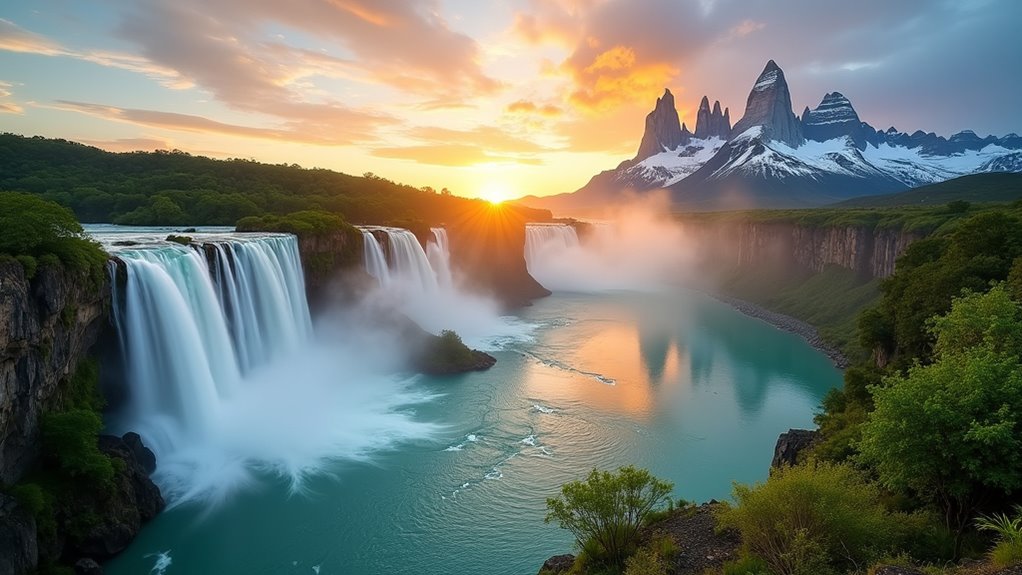
When deciding between Brazil and Argentina, you’re fundamentally choosing between two natural wonderlands with dramatically different offerings. Brazil dazzles with its 7,000 km of world-famous beaches like Copacabana, plus the incomparable Amazon rainforest covering 60% of the country. You’ll also find the Pantanal wetlands and unique landscapes like Lençóis Maranhenses’ surreal dune lagoons.
Argentina counters with Patagonia’s vast steppes and the spectacular Perito Moreno Glacier in UNESCO-listed Los Glaciares National Park. For adventure seekers, Argentina provides numerous opportunities to explore diverse natural landscapes through hiking, climbing, and wildlife viewing.
While both countries share Iguazu Falls, Argentina offers closer encounters with 80% of the 275 cascades, while Brazil provides sweeping panoramic views. Argentina also boasts Ushuaia, the world’s southernmost city, and a distinctive Lake District with alpine scenery.
Choosing between Brazil and Argentina means deciding between two distinctly different urban experiences, each with their own metropolitan character and scale.
Brazil offers megacities like São Paulo, with its modern skyscrapers and over 22 million residents, and Rio de Janeiro, famous for iconic landmarks like Christ the Redeemer.
Argentina’s urban scene centers around Buenos Aires, where European-style architecture lines grand boulevards. With nearly 16 million inhabitants, it’s smaller than Brazil’s largest cities but offers sophisticated cultural experiences. Argentina has an exceptionally high urban population rate with nearly 96% of its 45.8 million residents living in cities.
Cordoba provides a glimpse of preserved colonial heritage.
Both countries boast thriving urban economies—São Paulo functions as a business powerhouse while Buenos Aires serves as Argentina’s financial center.
You’ll find excellent amenities in both, though Brazil’s urban areas are considerably larger, presenting both greater diversity and more complex infrastructure challenges.
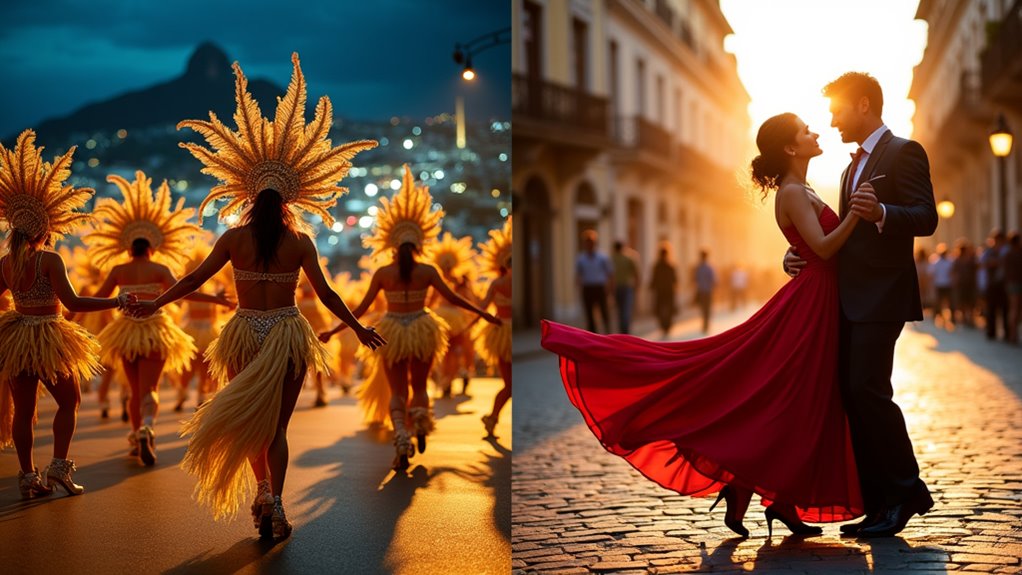
Beyond the bustling city centers, both Brazil and Argentina showcase their cultural identities through vibrant festivals that can transform your travel experience.
In Brazil, timing your visit for Carnival (February/March) offers unforgettable samba parades and street parties in Rio, Salvador, and Recife.
For culture, consider the indigenous-influenced Parintins Folklore Festival or the rhythm-filled Bumba Meu Boi in the Northeast. Many festival websites use necessary cookies to provide essential information about event dates and ticket availability.
Argentina’s festival calendar features the spectacular Gualeguaychú Carnival and the wine-centric Fiesta Nacional de la Vendimia in Mendoza.
Don’t miss the Tango Buenos Aires Festival if you’re passionate about this iconic dance form.
Both countries honor their diverse heritage through celebrations—from Brazil’s Afro-Brazilian Congada rituals to Argentina’s gaucho traditions during Día de la Tradición in November.
The gastronomic landscapes of Brazil and Argentina offer travelers distinctly different yet equally compelling culinary journeys shaped by their unique histories and cultural influences. Brazil’s cuisine reflects its multicultural heritage with Portuguese, African, and indigenous influences, while Argentina draws heavily from Italian immigrants.
Both countries celebrate food communally, with Brazilian family barbecues and Argentine Sunday lunches centering around shared meals.
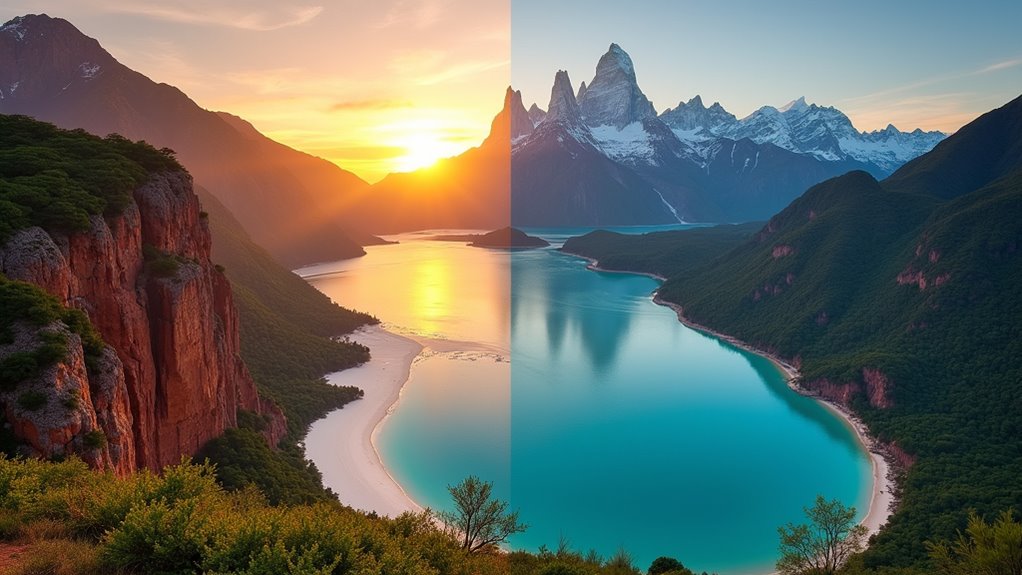
While food offers a sensory journey through each country’s culture, both Brazil and Argentina boast extraordinary landscapes that beckon adventure seekers.
Brazil fascinates with the world’s most biodiverse Amazon Rainforest, vast Pantanal wetlands, and 7,000km of surfable coastline. Brazil’s adventure tourism market leads the region at USD 6,123.44 million in 2024. You’ll find exceptional jungle treks, wildlife spotting, and water adventures from Florianópolis to Fernando de Noronha.
Brazil’s natural wonders showcase Earth’s ultimate biodiversity, where endless coastlines and dense jungles promise extraordinary adventures for the intrepid explorer.
Argentina counters with the dramatic Patagonian wilderness, towering Andes (including Aconcagua, the highest peak outside Asia), and the alpine-like Bariloche Lake District. Here, you can trek glaciers, climb mountains, or witness marine wildlife at Valdez Peninsula.
Both share the magnificent Iguazu Falls, though Brazil’s tourism sector is larger at $167 billion versus Argentina’s $2.4 billion adventure market. Your choice depends on whether rainforests and beaches or mountains and glaciers call to you.
Financial considerations often dictate travel decisions, and South America’s two largest countries present fascinating budget dynamics in 2025. Argentina’s plummeting peso has made it exceptionally affordable for international visitors, with daily costs averaging $85.62 compared to Brazil’s $88.22. While the difference seems minimal, it adds up over longer trips. Argentina has experienced dramatic price increases in tourist attractions, with sites like Tilcara’s pukara seeing twelvefold rises from 1,000 to 12,000 pesos per person.
Your currency’s strength against the peso or real will profoundly impact which destination offers better value for your specific situation.
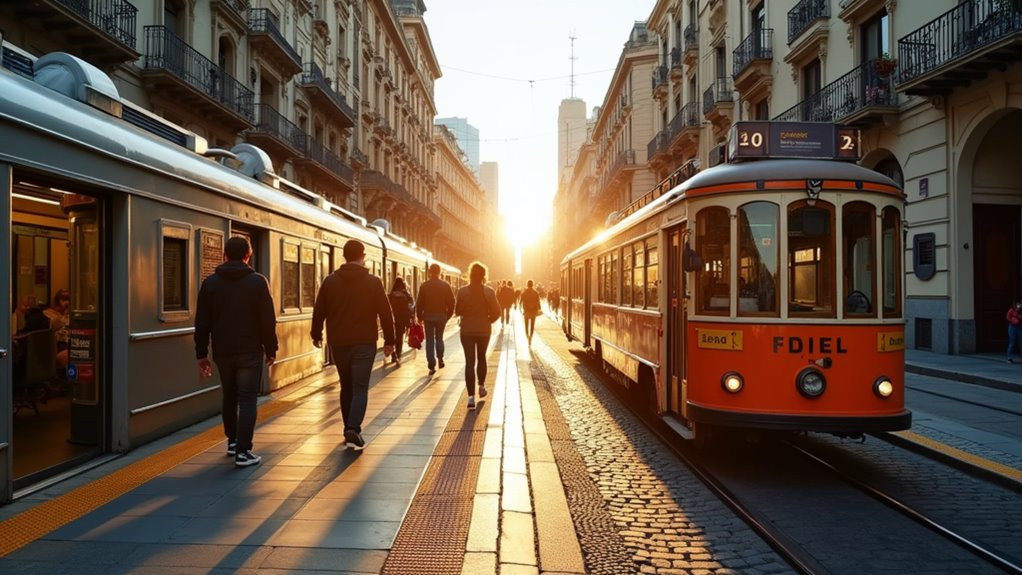
Traveling through Brazil and Argentina presents distinct challenges and opportunities for travelers in 2025, with each country offering unique transportation networks shaped by geography and infrastructure development.
In Brazil, you’ll navigate an extensive road network spanning over 2 million kilometers, though only a fraction is paved.
Argentina offers better paved road ratios with 117,616 km of its 281,290 km road network being paved.
For urban travel, Argentina has the advantage with Buenos Aires’ metro system and efficient Metrobus networks.
Long-distance buses dominate intercity travel in both countries, while air travel connects major destinations.
The MERCOSUR Route connects both nations, facilitating cross-border travel.
However, be prepared for occasional traffic congestion and varying road conditions, especially on rural routes away from main highways.
Both countries provide dropdown selection options allowing travelers to compare transportation statistics when planning their journey.
When planning your trip to South America in 2025, understanding the seasonal differences between Brazil and Argentina can substantially enhance your experience. Brazil offers year-round visitation with its tropical climate, while Argentina presents more pronounced seasonal variations.
Savvy travelers recognize that timing is everything when exploring South America’s diverse climates.
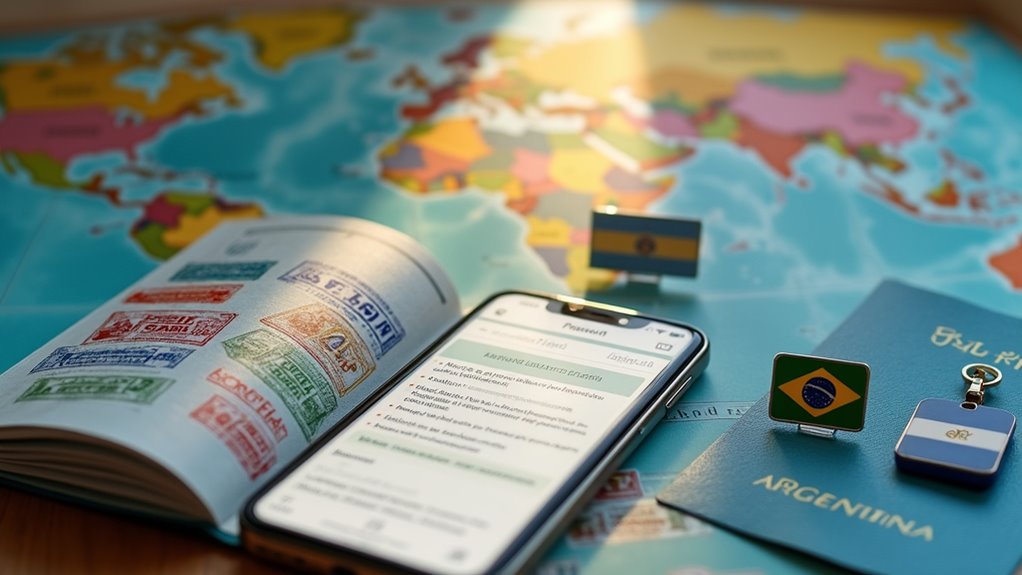
While planning for the perfect season to visit, securing the proper documentation for your South American adventure is just as important.
Brazil has recently reinstated visa requirements for U.S., Canadian, and Australian citizens as of April 2025. You’ll need to obtain an e-visa costing around $80.90, valid for up to 10 years. Applications can be submitted through the VFS Global platform, which is exclusively authorized by the Brazilian government to process visa applications.
Argentina offers a simpler entry process for these same nationalities, allowing visa-free tourist stays up to 90 days.
Both countries require valid passports, but Brazil demands at least one blank page for stamps.
Health documentation varies by destination—yellow fever vaccination certificates may be needed, especially when traveling between certain regions.
Always carry proof of sufficient funds and return tickets, as immigration officers might request these upon arrival in either country.
Safety concerns shouldn’t deter you from experiencing the wonders of South America, though understanding the distinct security landscapes of Brazil and Argentina is essential. Argentina ranks considerably higher on the Global Peace Index with a Level 1 advisory, while Brazil carries a Level 2 rating requiring increased caution, particularly in urban areas.
Regardless of your destination, follow these critical safety practices:
Whether you choose Brazil’s jaw-dropping rainforests or Argentina’s soul-stirring Patagonia, you can’t go wrong. Each country offers a million reasons to visit, from vibrant urban centers to unique cultural experiences. Consider your travel priorities—adventure, food, festivals, or city life—and plan accordingly. Whatever you decide, South America’s two largest countries will reward you with memories that last a lifetime.